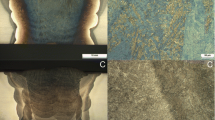Abstract
Welding of service-exposed, aged heat-resistant nickel-base alloys is notoriously difficult. There is a high propensity for cracking in the heat-affected zone (HAZ) of the weld which manifests during or immediately after the welding process due to creep induced embrittlement. The cracks due to creep induced embrittlement are typically accelerated by high residual stresses. To minimize this damage mechanism, the original weld procedure was modified from a double-angle V-groove to a U-groove, and a stringer pattern was used instead of weaving at a higher interpass temperature. Welds were prepared and tested using the modified procedure which was beneficial in minimizing the occurrence of fissures and subsequent cracking due to creep induced embrittlement. Comparative hardness testing of the original and modified weld procedures’ revealed a reduced HAZ width with the modified procedure that most likely facilitated the minimization of creep induced embrittlement.
Similar content being viewed by others
References
D. Knowles, K. Buchanan, M. Kral, Condition assessment strategies in centrifugally cast HP steam reformer tube alloys, in ECCC Creep Conference (Zurich, 2009)
S. Shi, J.C. Lippold, Microstructure evolution during service exposure of two cast, heat-resisting stainless steels—HP-Nb modified and 20–32Nb. Mater. Charact. 59(8), 1029–1040 (2008)
D. Allen et al., Creep rupture and ductility of as-manufactured and service-aged nickel alloy IN617 materials and welds. Mater. High Temp. 21(1), 55–60 (2004)
J. Vekeman, M.D. Waele, Repair Welding of HP40-Nb (Belgian Welding Institute, Brussels, 2015)
S.K. Bhaumik, R. Rangaraju, M.A. Parameswara, Failure of reformer tube of an ammonia plant. Eng. Fail. Anal. 9, 553–561 (2002)
J. Huber, D. Jakobi, Centricast materials for high temperature service, in International Conference and Exhibition for Nitrogen and Syngas (Dusseldorf, 2011)
C.M. Schillmoller, HP-modified furnace tubes for steam reformers and steam crackers. NiDi Technical Series, No. 10,058 (1992)
M. Garbiak, W. Jasiński, B. Piekarski, Materials for Reformer Furnace Tubes. History of evolution. Arch. Found. Eng. 11(2), 47–52 (2011)
Foster Wheeler, Steam-Hydrocarbon Reformer Furnace Design (Foster Wheeler, London, 2006). (unpublished)
D. Peckner, I.M. Bernstein, Handbook of Stainless Steels (McGraw-Hill, New York, 1977)
J.R. Davis, Corrosion of Weldments (ASM International, Materials Park, 2006)
C. Weisman, Fundamentals of Welding, vol. 1, Welding Handbook (American Welding Society, Miami, 1976)
J.F. Lancaster, Metallurgy of Welding (George Allen & Unwin Ltd., Crows Nest, 1980)
T.G. Gooch, J. Honeycombe, Welding variables and microfissuring in austenitic stainless steel weld metal. AWS Weld. Res. Suppl. 55, 234s (1980)
S.K. Bate, D. Green, D. Buttle, A Review of Residual Stress Distributions in Welded Joints for the Defect Assessment of Offshore Structures. Offshore Technology Report, 1997 (OTH 482)
F. Jonassen, J.L. Meriam, E. DeGarmo, Effect of certain block and other special welding procedures on residual welding stresses. Weld. J. 25(9), 492s–496s (1946)
H. Kihara, K. Masubuchi, Y. Matsuyama, Effect of Welding Sequence on Transverse Shrinkage and Residual Stress (Transportation Technical Research Institute, Tokyo, 1957)
S. Ziaee, M.H. Kadivar, K. Jafarpur, A sequence scheme to reduce the residual stresses in welding of circular elements. Iran. J. Sci. Technol. 32(B4), 367–383 (2008)
D. Smith, Welding Skills and Technology (McGraw-Hill Inc., New York, 1984)
G.R. Stevick, I. Finnie, Failure assessment of weldments at elevated temperatures, in 6th International Conference on Mechanical Behaviour of Materials (Kyoto, 1991)
J.F. Henry, F.V. Ellis, C.D. Lundin, The influence of flux composition on the elevated temperature properties of Cr–Mo submerged arc weldments. Weld. Res. Counc. Bull. 354(6), 39–132 (1990)
B.F. Dixon, R.H. Phillips, J.C. Ritter, Solidification cracking: causes, remedies and the transvarestraint test, in 31st Annual Conference of the Australian Welding Institute (Sydney, 1983)
R.S. Funderburk, Fundamentals of preheat. Weld. Innov. Q. 14(2), 14–15 (1997)
R.S. Funderburk, The importance of interpass temperature. Weld. Innov. Q. 15(1), 1–2 (1998)
M. Lord, G. Jennings, Effect of interpass temperature on properties of high-strength weld metals. Svetsaren J. 54(1–2), 53–58 (1999)
J.C. Lippold, W.A. Baeslack III, I. Varol, Heat affected zone liquation cracking in austenitic and duplex stainless steels. Weld. J. 71, 1–14 (1992)
J.S. Petro, Effect of Interpass Temperature on the Structure and Properties of Multipass Weldments in High Performance Nickel Alloys (Department of Mechanical Engineering, Colorado State University, Fort Collins, 2011)
K. Hasegawa, Repair welding and metallurgy of HP-modified alloy after long term operation, in Metal 2001 (Czech Republic, 2001)
R.S. Funderburk, A look at heat input. Weld. Innov. Q. 16(1), 8–11 (1999)
H.K. Chavan, G.D. Shelake, M.S. Kadam, Effect of heat input and speed of welding on distortion in MIG welding. Int. J. Ind. Eng. Res. Dev. 3(2), 42–50 (2012)
Schmidt + Clemens, Weld Procedure. Old Reformer Tube to Old Reformer Tube. Material: Centralloy G 4852 Micro & Centralloy G 4859 (Schmidt + Clemens, Houston, 2015)
S.Y. Merchant, Investigation on effect of heat input on cooling rate and mechanical property (hardness) of mild steel weld joint by MMAW process. Int. J. Mod. Eng. Res. 5(3), 34–41 (2015)
K. Poorhaydari, B. Patchett, D. Ivey, Estimation of cooling rate in the welding of plates with intermediate thickness. Weld. J. 84(10), 149s–155s (2005)
K. Masubuchi, D.W. Hopkins, Analysis of Welded Structures: Residual Stresses, Distortion, and Their Consequences (Elsevier, Amsterdam, 2013)
S. Shi, J. Lippold, J. Ramirez, Hot ductility behavior and repair weldability of service-aged, heat-resistant stainless steel castings. Weld. J. 89(10), 210–217 (2010)
G.F. Vander-Voort, G.M. Lucas, E.P. Manilova, ASM Metals Handbook: Volume 9, Metallography and Microstructures (ASM International, New York, 2004)
ASTM International, ASTM A297/A297M-17 standard specification for steel castings, iron–chromium and iron–chromium–nickel, heat resistant, for general application, in Book of Standards Volume: 01.02. (ASTM International, New York, 2017)
The Welding Institute, Recommended welded connections for pipework (Cambridge, 1965)
Author information
Authors and Affiliations
Corresponding author
Rights and permissions
About this article
Cite this article
Rampat, K., Maharaj, C. Improving the Weld Procedure for Aged HP-Mod Alloy Reformer Tubes. Metallogr. Microstruct. Anal. 7, 493–503 (2018). https://doi.org/10.1007/s13632-018-0469-7
Received:
Revised:
Accepted:
Published:
Issue Date:
DOI: https://doi.org/10.1007/s13632-018-0469-7














